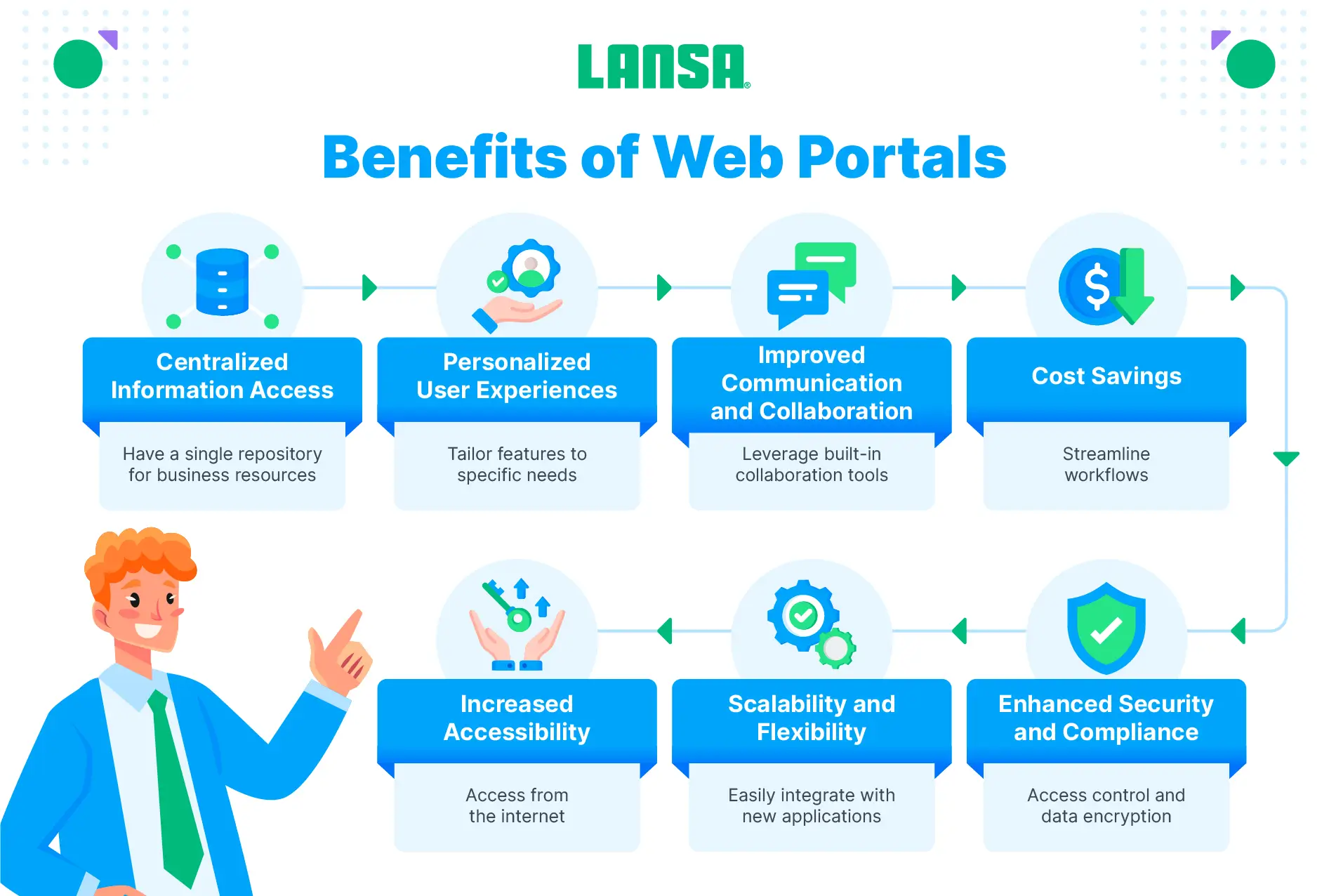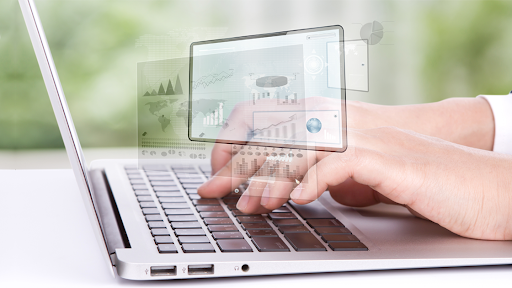Navigating the vast digital landscape can be overwhelming. Web portals act as gateways, streamlining access to critical resources and functionalities and providing a collaborative platform that fosters seamless communication.
Key insights
- Web portals are different from websites. While websites provide general information, web portals offer specific groups of users access to a range of services and data.
- There are many types of web portals, from client and vendor portals to corporate intranets and extranets.
- Web portals have evolved. Web portals have evolved from simple platforms to comprehensive portal platforms supporting digital customer experiences.
- Web portals offer many benefits. They offer centralized information, personalized experiences, improved collaboration, cost savings, enhanced security, scalability, and accessibility.
What Is a Web Portal?
What is an online portal? A web portal is a dynamic and feature-rich web application that serves as a centralized access point for a specific audience. It aggregates information and services from various sources, presenting them in a unified and personalized way.
Web portals are important in today’s information-dense environment for several reasons. They combat information overload by acting as a single point of entry. Without a web portal, users would have to manage multiple applications, websites, and logins for different tasks. A portal website also offers personalization. Users can tailor the information and functionalities they see based on their roles, preferences, or past interactions.
A web portal also fosters collaboration and communication by providing shared workspaces, discussion forums, and communication tools, allowing teams to work together seamlessly. This is particularly valuable for organizations with geographically dispersed teams or those working on complex projects.
A web portal empowers users with increased control and efficiency. They simplify information access, personalize the user experience, and foster collaboration, making them a cornerstone of the modern digital landscape.
Web Portal vs Website: What Is the Difference?
While you may be asking, “What is a portal website?” The definition of a web portal goes beyond “website.” Think of a website as a single building. It serves a specific purpose, offers certain products or information, and caters to a general audience. A web portal, in contrast, is more like a town square. It acts as a central hub, bringing together various resources and functionalities under one roof.
A web portal is a centralized online platform, and here are some of its key differences from a website:
- Purpose: Websites typically serve a singular purpose, such as showcasing a company’s products or providing information about specific topics. A web portal, on the other hand, aggregates information and services from many sources, catering to a more targeted audience with specialized needs.
- Content and functionality: Websites typically offer static content or limited functionalities like contact forms or online brochures. A web portal, however, is a dynamic environment. It can integrate features like personalized dashboards, user profiles, search functionalities, and communication tools.
- User experience: Websites generally offer a one-size-fits-all experience. A web portal, on the other hand, can personalize user experiences by tailoring content and functionalities based on user roles, preferences, or past interactions.
- Security: Security requirements can vary depending on a website’s purpose. A web portal, however, often handles sensitive information and requires robust security measures to ensure user privacy and data protection. This is particularly true for secure IBM i portals, which often manage critical business information within organizations.
10 Web Portal Types
While the concept of a web portal is broad, there are various web portal examples, that cater to specific industries, purposes, and user groups. Here are 10 common types of web portals:
Client Portals
These secure online spaces function as a communication and collaboration hub between companies and their clients. A client portal typically offers features like account management, document sharing, project progress tracking, and support ticket systems.
Vendor Portals
Similar to client portals, vendor portals provide a platform for streamlined communication and collaboration between a company and its vendors or suppliers. A vendor portal can facilitate tasks such as order management, inventory tracking, invoice processing, and communication channels.
Education Portals
In the education sector, a web portal acts as a virtual learning environment. An education portal offers students a centralized location to access course materials, submit assignments, take quizzes online, and interact with instructors and classmates. These web portals can also provide faculty with tools for managing classes, delivering lectures, and tracking student progress.
Government Portals
Many government websites now offer a variety of services through a web portal. A government portal acts as a one-stop shop for citizens to access government services, apply for licenses or permits, track applications, and pay taxes electronically.
Corporate Intranets/Extranets
Corporate intranets provide employees with a secure platform to access company resources, collaborate on projects, communicate with colleagues, and stay updated on company news and announcements. Extranets extend this functionality to authorized external parties, such as vendors or partners.
eCommerce Portals
The online shopping experience we know today is often powered by an eCommerce web portal. ECommerce portals provide a platform for businesses to showcase their products, facilitate secure transactions, manage customer accounts, and offer features like order tracking and customer support.
Patient Portals
This type of secure web portal allows patients to manage their health information. Patient portals typically allow users to schedule appointments, view lab results, communicate with doctors, and even refill prescriptions. Healthcare providers will also have internal portals, but the online portal meaning for them will differ from the one used by patients.
Community Portals
These online spaces connect individuals with similar interests or hobbies. Community portals typically provide forums for discussion, resource sharing, event calendars, and member profiles.
Partner Portals
Businesses often collaborate with strategic partners. A partner portal creates a secure online environment for these partnerships to thrive. They can facilitate communication, document sharing, project management tools, and joint marketing initiatives.
Banking and Insurance Portals
Financial institutions will often leverage a web portal to empower us to manage our finances. Banking or insurance portals provide secure access to account information, online bill payments, investment tracking, and communication channels with customer service representatives.
Evolution of Web Portals
Web portals have undergone a significant transformation since the early days as glorified directories. If you haven’t used a web portal in a while, how you define a web portal might not fit the modern web portal definition.
An early web portal primarily functioned as an entry point, offering basic functionalities like search engines and links to various websites. They were more like advanced online directories, helpful for navigating the web but lacking the sophistication of today’s offerings.
The evolution of the web portal has been driven by the growing need for better user experience, personalization, and functionality. A modern web portal is a comprehensive platform that supports digital customer experiences. Here’s how:
- Advanced features: A modern web portal integrates many advanced functionalities. Content Management systems allow for dynamic and up-to-date information delivery while marketing automation tools personalize the user experience by tailoring content and offerings based on user preferences or interactions.
- Mobile support: A modern web portal is optimized for mobile devices, ensuring a seamless user experience regardless of the device used.
- User experience focus: A modern web portal prioritizes user experience by offering intuitive interfaces, personalized dashboards, and interactive elements.
Modern Portal Platforms
Modern web portals, like those created with Portalize, have transcended their role as simple information hubs. Portals have evolved into full-fledged web portal platforms, acting as the nerve center for many digital experiences. A modern web portal is characterized by three key features:
- Integration: A modern web portal platform excels at bringing together disparate systems and data sources. They seamlessly integrate with existing CRM, ERP, and marketing automation tools, creating a unified view of the customer and streamlining workflows. By eliminating the need for users to navigate multiple logins and applications, web portals boost efficiency and productivity.
- Consistency: A modern web portal platform ensures consistent branding, messaging, and navigation across all access points, be it desktop, mobile, or tablet. This creates a sense of familiarity and reduces user confusion, regardless of the device used.
- Personalization: A modern web portal leverages user data and behavior patterns to deliver personalized content, recommendations, and functionalities. This user-centric approach fosters engagement, increases customer satisfaction, and drives conversions.
By harnessing these characteristics, a modern web portal platform is the cornerstone of successful digital transformation initiatives.
Customers expect a seamless experience across all touchpoints, and a modern web portal enables omnichannel user experiences. By integrating various communication channels, such as email, chatbots, and social media, they create a unified platform for customer interaction, regardless of the channel used. This empowers businesses to deliver exceptional customer service, build stronger relationships, and drive customer loyalty more quickly and efficiently.
Learn how to create web portals with productivity and speed in mind.
Benefits of Web Portals
We’ve explored the evolution and functionalities of web portals. But what does a portal mean to a business? Web portals offer a multitude of benefits, streamlining workflows, boosting user experience, and driving success. Let’s explain the benefits of web portals by exploring how they address key challenges faced by organizations.

From Web Portal to Digital Experience Platforms
Web portals have demonstrably transformed how we access information and interact online. But the evolution doesn’t stop there. As technology continues to advance and user expectations rise, web portals are morphing into even more sophisticated entities: Digital Experience Platforms (DXPs).
Digital experience platforms go beyond the core functionalities of a web portal. They act as comprehensive ecosystems that orchestrate the entire usage journey, encompassing every touchpoint a user might have with a brand. DXPs seamlessly integrate web portals, content management systems, marketing automation tools, and even artificial intelligence to deliver hyper-personalized experiences across all channels.
While a web portal can excel at providing a central hub for information access and user interaction, A digital experience platform elevates this experience to a whole new level. DXPs leverage data analytics and user behavior to personalize content, recommendations, and interactions in real time. This future-oriented approach empowers businesses to build strong customer relationships, drive loyalty, and achieve their digital transformation goals.
Portalize is actively innovating to bridge the gap between web portals and DXPs. This portal framework is loaded with the most essential portal features right out of the box, allowing businesses to leverage the power of both web portals and digital experience platforms.
Learn how to build superior user experience portals that function as powerful DXPs.
To Sum Up
Web portals have come a long way from their humble beginnings as online directories. Today, they are powerful tools that streamline workflows, empower collaboration, and personalize user experiences. Modern web portals, integrated within Digital Experience Platforms, offer the potential to orchestrate the entire user journey, fostering deeper customer connections and driving business success.
Whether you’re looking to improve internal communication, enhance customer service, or simply provide a one-stop shop for information, a web portal solution can be a valuable asset, and with a framework like Portalize, it is simpler to implement than ever before. As technology continues to evolve, web portals will undoubtedly continue to adapt and innovate, remaining at the forefront of digital transformation initiatives. Learn more about how a custom web portal can fit even the most sophisticated marketing needs.









